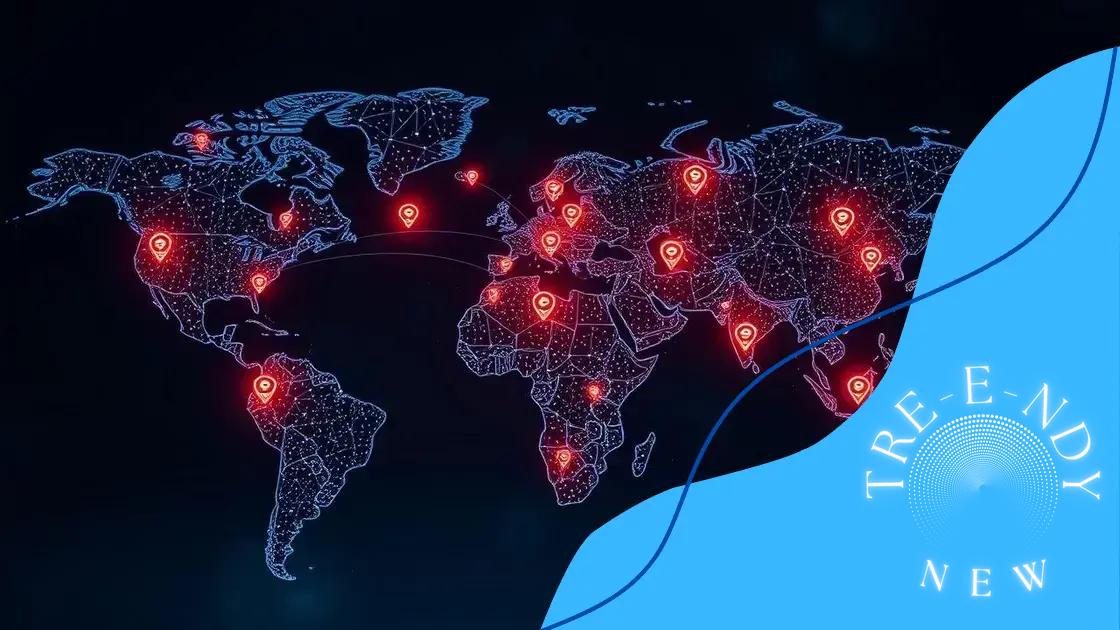Blockchain in global remittances: a game changer

Blockchain in global remittances significantly lowers fees and increases transaction speed by eliminating intermediaries and providing secure, efficient cross-border payment solutions.
Blockchain in global remittances is reshaping how we think about transferring money internationally. Have you ever wondered if sending money abroad could be faster and more affordable? This technology is paving the way for a revolution in remittances.
Understanding blockchain technology
Understanding blockchain technology is crucial, especially as it becomes more integrated into our daily lives. It is a database that is shared across a network of computers, making it both transparent and secure. This technology allows transactions to be recorded in a way that prevents tampering.
One of the key features of blockchain is its decentralized nature. Unlike traditional banking systems, where a single entity controls the data, blockchain distributes this authority among many participants. This means no single point of failure, enhancing security and reliability.
How Blockchain Works
The basic structure of a blockchain includes blocks that hold data. Each block is linked to the previous one, forming a chain. This connection makes it nearly impossible to alter any information without altering all subsequent blocks.
- Every block contains a unique code called a hash.
- Blocks also store the hash of the previous block.
- This structure creates a secure chain of blocks.
- Transactions are verified by network participants, known as nodes.
This process not only ensures accuracy but also promotes trust among users, as everyone can view and verify transactions. Furthermore, blockchain technology enables smart contracts, which automatically execute agreements when certain conditions are met, minimizing the need for intermediaries.
As we explore these concepts further, it’s essential to recognize how blockchain is paving the way for innovations in various fields, including finance, healthcare, and supply chain management. Its potential to create efficiency and transparency is truly revolutionary.
The impact of blockchain on remittance fees
The impact of blockchain on remittance fees is significant and growing. Traditional money transfer services often charge high fees, making it expensive for people to send money abroad. However, blockchain technology is changing this landscape, allowing for much lower service costs.
By eliminating intermediaries, blockchain reduces the need for multiple banks or services, which can significantly drive down transactional fees. Users can benefit from faster transactions, with money reaching its destination almost instantly.
How Blockchain Reduces Fees
Below are key ways through which blockchain impacts remittance costs:
- Decentralization: Eliminating central authorities cuts down costs.
- Efficiency: Transactions are processed faster, reducing operational overhead.
- Transparency: Users can see the full transaction history, ensuring no hidden fees.
- Smart contracts: These can automate payments, removing further costs.
This lowered fee structure is especially beneficial for migrant workers who rely on remittances to support families back home. High remittance fees can eat into the support that loved ones receive, making affordable solutions vital.
The move towards blockchain in remittances is not merely theoretical but already happening worldwide. Many companies are adopting this technology to facilitate low-cost, effective transfers. By integrating blockchain solutions, users find themselves empowered to send money without the burden of steep fees.
Case studies of successful blockchain implementations

Case studies of successful blockchain implementations provide valuable insights into how this technology can be utilized across various industries. These real-world examples demonstrate the potential of blockchain to solve real problems and improve processes.
One notable case is in the supply chain industry, where companies use blockchain to track products from origin to consumer. This transparency increases trust and reduces fraud. For example, a major food retailer has adopted blockchain to trace the source of its produce, enabling quicker response times during food safety inspections.
Key Industries Utilizing Blockchain
Several sectors are leveraging blockchain technology to enhance efficiency:
- Finance: Banks are rapidly adopting blockchain for faster transactions and enhanced security.
- Healthcare: Patient records can be securely shared between institutions, ensuring privacy and accuracy.
- Real Estate: Blockchain simplifies property transactions and recording ownership.
- Energy: Renewable energy credits are tracked on blockchain, enhancing transparency.
In the finance sector, companies like Ripple have shown how blockchain can facilitate cross-border payments at a fraction of the cost and time compared to traditional methods. Similarly, in the healthcare field, the MediLedger project allows for a secure share of pharmaceutical data, eliminating fraud and ensuring compliance.
These implementations highlight not only the versatility of blockchain but also its capability to bring significant cost savings and efficiency improvements in daily operations. Businesses adopting these technologies can expect to enhance customer trust and streamline processes, positioning themselves competitively in the market.
Challenges faced by blockchain in remittances
Despite the advantages, there are several challenges faced by blockchain in remittances that need to be addressed for broader adoption. These obstacles can hinder the potential impact of blockchain technology in money transfers.
One significant challenge is the regulatory landscape. Many countries have different regulations governing cryptocurrency and blockchain use, leading to confusion and uncertainty among users. This discrepancy can slow down the integration of blockchain in remittance services.
Key Challenges in Blockchain Remittances
Several issues make implementing blockchain for remittances difficult:
- Scalability: As the number of users grows, transactions could slow down, causing delays.
- Security concerns: While blockchain is secure, vulnerabilities can still exist, leading to potential hacks.
- User understanding: Many users may not fully understand how blockchain works, leading to trust issues.
- Energy consumption: Some blockchain networks can require vast amounts of energy for transactions, raising environmental concerns.
These challenges can also create a barrier to entry for many businesses looking to implement blockchain solutions. Overcoming these hurdles requires collaboration among stakeholders, including technology providers, governments, and financial institutions.
Furthermore, the competition from established money transfer services is significant. These companies have built loyal customer bases and may be hesitant to adopt new technologies that disrupt traditional methods. Addressing customer education about the benefits of blockchain and how it operates will be crucial in gaining trust and facilitating its acceptance in the remittance sector.
Future trends in blockchain and money transfers
The future trends in blockchain and money transfers indicate a bright and evolving landscape. As technology continues to advance, blockchain is expected to reshape how we manage and transfer money across borders. This evolution is driven by innovation, user demand, and the need for efficiency.
One significant trend is the increasing adoption of cryptocurrencies. As digital currencies become more mainstream, they offer a viable alternative to traditional fiat currencies for remittances. Many people are already using cryptocurrencies to avoid high fees and long wait times associated with conventional money transfer methods.
Emerging Developments
Several factors are likely to influence the future of blockchain in money transfers:
- Interoperability: Increased collaboration between different blockchain networks will make transferring value smoother.
- Enhanced regulations: Clearer regulations will build trust and provide guidelines for users and businesses.
- Mobile integration: Growth in mobile wallet usage will facilitate easier access to blockchain technology, especially in developing regions.
- Decentralized finance (DeFi): This will open new possibilities for borrowing, lending, and earning interest outside traditional banking systems.
Blockchain-based platforms are also likely to enhance user experience by providing faster transaction speeds and better security features. Additionally, the concept of smart contracts is expected to mature, enabling automated transactions that are secure and trustworthy.
As these trends unfold, we can expect to see improvements in financial inclusion, allowing more people to participate in the global economy. In many regions that rely heavily on remittances, blockchain technology can deliver more efficient services, making it easier for families to receive support from their loved ones abroad.
FAQ – Frequently Asked Questions about Blockchain in Global Remittances
How does blockchain lower remittance fees?
Blockchain eliminates intermediaries and reduces the costs associated with traditional money transfers, making remittances cheaper.
What challenges does blockchain face in remittance services?
Challenges include regulatory uncertainty, scalability issues, security concerns, and the need for user education.
What is the role of cryptocurrencies in remittances?
Cryptocurrencies provide an alternative for cross-border transfers, allowing for faster and cheaper solutions compared to banks.
How can blockchain promote financial inclusion?
By providing access to affordable financial services, blockchain can help underserved populations participate in the global economy.





